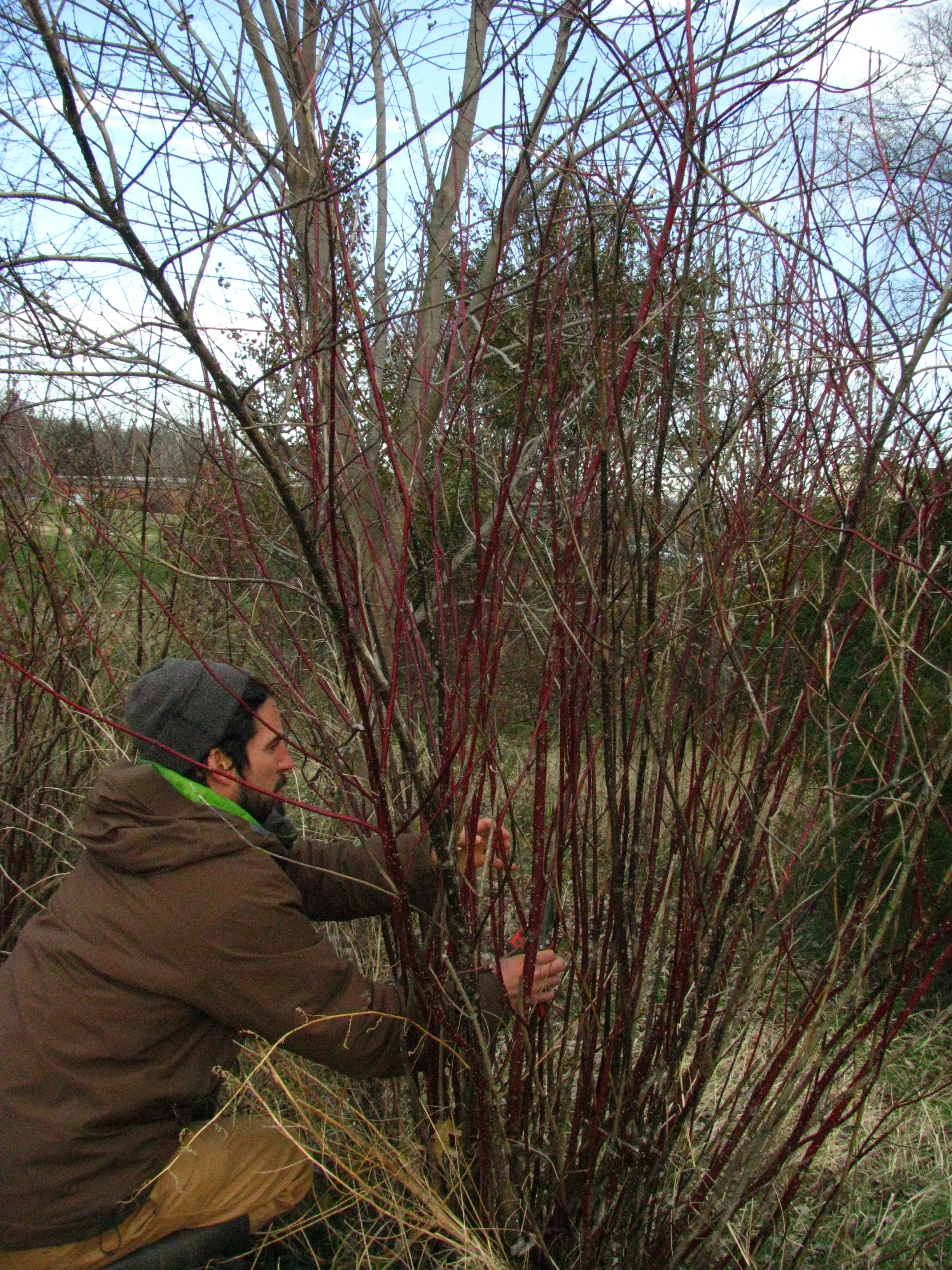Dogwood Shrub






Dogwood Shrub
Cornus spp.
Plant for watershed restoration, for food and medicine, for wildlife shelter, for baskets and beauty, and for gratitude!
Red Osier: Hardy from Zone 2-7. 6-9 feet tall, 8-12 feet wide.
Silky: Hardy from Zones 4-8. 6-10 feet tall, 8-12 feet wide.
We’re drawn to Dogwoods throughout the year, to the blocked bark, soft blossoms, and bright berries. The famed flowers once served as a sign to farmers that spring had come and crops could be safely planted. Members of the Cornus genus are native to temperate and boreal forests of Eurasia and North America, particularly the southeastern section of this settler colonial society. The name comes to us from the early 1600s, when Dogwood was also known as the whipple-tree. Perhaps “dogwood” references the bark’s use as treatment for mange, or possibly descends from the Old English dag, as in daggers or arrows, which were made from the strong stems. Seems reasonable, as the hardy wood has been used for tool handles, roller skates, golf club heads, and looms. An old Christian folk tale suggests that Jesus was crucified on a Cornus cross. At the time, Dogwood was supposedly a much larger tree surrounding Jerusalem. But after the resurrection, Jesus shrunk and twisted the tree to prevent using it again in the public political execution of crucifixion. A Dogwood or not, the late and powerful Kenyan tree planter and activist Wangari Maathai once said that a tree was cut down to crucify Jesus. As such, Christians should thank every tree they pass and plant more. Let’s see more churchyards, and yards of all kinds, made useful with Dogwood flowers, and let’s see more streambanks etched with the brilliant red branches of Dogwood shrubs like Red Osier and Silky Dogwood!
Red Osier (Cornus sericea) grows all over North America. Sometimes called Red Willow or Creek Dogwood, this Cornus family member often lives in wetland soils and waterways, spreading through stolons to form thickets along creeks and ponds. Restoration projects commonly use Red Osier to prevent streambank erosion because of their incredible root system and because they’re so easy to propagate: simply cut off a branch and stick it in the ground! Sericea means silky, referring to the texture of the leaves, which turn red or purple in Autumn. We grow Cardinal, a cultivar of Red Osier that grows quickly into multiple red stems, and a chartreuse-colored cultivar called ‘Flaviramia,’ also called Yellow Twig Dogwood.
Indigenous tribes have had many uses for Red Osier. Chinook and Interior Salish people of the Plateau tribes have used the berries to treat colds and stop bleeding. Many tribes (Cheyenne, Lakota, Ponca, Apache, Potawatomi, etc.) mix the inner bark with tobacco for sacred pipe ceremonies. Ojibwe (or Chippewa) people have used the bark for similar purposes and as a dye for clothes and animal hides, as well as an infusion with the bark to ward off diarrhea and treat poison ivy, sore eyes, and mucous buildup; the Shuswap use the plant to support kidney health and to help children who wet the bed! The Maidu make a decoction for women after childbirth. Most white European-descended people don’t think about Dogwood’s bitter berries as food, but the southern Interior tribes of British Columbia all ate the small fruits, often mixed with other berries or mashed and dried into cakes. The Nlaka’pamux considered the raw berries a good tonic. The wood itself also provided gifts to people who perceived them. The Potawotami tribe originated Dreamcatchers, which they made with Red Osier stems. These flexible strong stems were used for bows, arrows, and basketweaving. Stems gathered and dried in early spring keep the brilliant red. The Three Affiliated Tribes of the Hidatsa, Arikara, and Mandan weave Red Osier with Willow and Boxelder splints to make plaited two-toned baskets.
Silky Dogwood (Cornus amomum) isn’t sericea but they’re still called Silky! Ranging from Ontario down to Arkansas, this Dogwood has a very similar growth habit and ecological niche to sericea. Silky prefers moist soils, growing in thickets along streams to stabilize steep slopes. Thicket-forming tendencies also serve as effective windbreaks for farms and natural borders for wildlife conservation. We enjoy seeing the white-yellow flowers in spring and rusty-colored leaves in Autumn. Silky is also known as the Kinnikinnik plant, a word from the Unami Delaware language, descended from Proto-Algonquin, that means “to mix something animate with something inanimate.” Kinnikinnik is an herbal smoking mixture of leaves and bark, including Silky, Red Osier, and varieties of Sumac.
These two shrubs can look pretty similar, both with red twigs and dark green oval leaves (unless, of course, you’ve got Flaviramia!). The easiest way to tell the difference is that young Silky branches have a brown pith, creamy white flowers, and blue fruit while Red Osier branches have a white pith, flowers, and fruit.
We propagate our Red Osier (Cardinal and Flaviramia) and Silky as cuttings from our streamside stands and other restoration plantings. Push the stakes halfway down into moist soil (right-side up!) or stick them into potting soil until they root out and then transplant.